
PDF Publication Title:
Text from PDF Page: 030
2.6.1.4 Vanadium/bromine Because there are limits to how much vanadium can be stored in solution in the VRFB system, some of the same researchers who pioneered the work on the VRFB cell noted that vanadium solubility could be boosted in the presence of halide ions. In this case, during charging the bromide ions in the positive half-cell undergo oxidation to what is assumed to be the polyhalide ion Br2Cl-. The formal potential of this couple is about 1.3 V more positive than the V2+/V3+ couple103–105. The researchers were able to show significantly higher solubility in this system, where vanadium/bromide solutions with nearly twice the solubility on a molar basis relative to vanadium sulfate solutions was demonstrated. The higher solubility of vanadium/bromine results in higher energy densities (35-70 Wh/L) compared to the VRFB systems (25-35 Wh/L). However, the potential concern of vanadium/bromine redox systems is toxic bromine vapor emissions during operation, and thus Skyllas- Kazacos also used bromine complexing agents including tetrabutylammonium bromine, polyethylene glycol, N-methyl-N-ethyl morpholinium bromide, and N- methyl-N-ethyl pyrrolidinium bromide to decrease or eliminate bromine vapor emissions during operation106. Generally, the Coulombic efficiency increases with increasing current density due to lower self-discharge through the membrane. However, it decreases as temperature increases due to more rapid diffusion of vanadium and polybromide ions through the membrane. 2.6.1.5 Hydrogen-based systems A fuel cell takes a fuel, normally hydrogen, and an oxidant, typically air, and produces electricity and water. A typical fuel cell produces a voltage from 0.6 V to 0.7 V with 2-3 kWhL-1, hydrogen oxidizes at the anode according to the reaction and, at the cathode, oxygen is reduced (2.7) (2.8) If one were to design a system where the fuel cell acts in both the charge and discharge directions (i.e. a reversible or regenerative fuel cell), then a RFB system would exist. Such a RFB system has been examined both with the same and different stacks for charge and discharge107–109. This system is inherently different from the RFBs discussed above since the reactants are in the gas phase not liquid storage in a tank, and thus hydrogen compression or novel hydrogen storage materials are needed. Although mass transfer is typically rapid, the oxygen reactions are known to be very sluggish and result in very large overpotentials110, thereby rendering the overall efficiency of the system to be very low. To enhance as well as drive down cost of the hydrogen/oxygen system, strategies including 29PDF Image | Redox Flow Batteries Vanadium to Earth Quinones

PDF Search Title:
Redox Flow Batteries Vanadium to Earth QuinonesOriginal File Name Searched:
FJVG_TESIS.pdfDIY PDF Search: Google It | Yahoo | Bing
Salgenx Redox Flow Battery Technology: Salt water flow battery technology with low cost and great energy density that can be used for power storage and thermal storage. Let us de-risk your production using our license. Our aqueous flow battery is less cost than Tesla Megapack and available faster. Redox flow battery. No membrane needed like with Vanadium, or Bromine. Salgenx flow battery
| CONTACT TEL: 608-238-6001 Email: greg@salgenx.com | RSS | AMP |